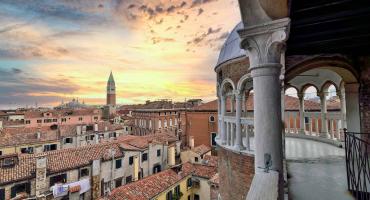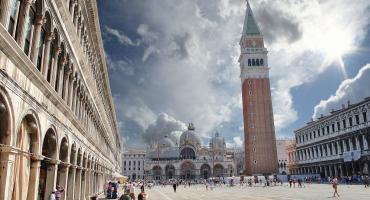After being closed for restoration during the last two years, the Clock Tower is finally given back to venetians and it's ready to continue beating the hours in Saint Mark's square from its dominating position at the entrance of Mercerie. The Clock Tower is one of the most important symbols of Saint Mark's Square. Ruling at the apex of the clock tower are the Giants (one young and one old, showing the passage of time) who bang out the hours with their hammers. They have blackened over the years and are now known as the "Mori".
From the end of the 1400s and well into the 1600s St Mark's Square, at the heart of Venice's political and religious life, underwent a series of modifications. It was from the Clock Tower that these modifications began. In 1493 Zuan Carlo Ranieri of Reggio Emilia was commissioned to build a new clock to substitute the St Alipio hammer clock. In 1495 the Senate, in agreement with the Procuratori de Supra decided to place the clock at the beginning of the Merceria. Work started in 1496, the tower being designed, as believed today by scholars, by Marco Codussi.
Two archways belonging to the Antiche Procuratorie were knocked down to make room for the new construction while adjacent buildings were reinforced. The works progessed at such speed that construction was complete towards the end of 1497. On the 1st of December of the same year, master ironworker Simone completed the bell, now to be found dominating the top level of the tower.
Ten days later master Ambrogio delle Anchore completed the two Giants holding hammers and saw them put in place. Artists of many different disciplines worked together on the decoration and internal mechanism of the clock which was finished by, and inaugurated on, February 1st,1499. It is no coincidence that the clock was erected at the beginning of the Merceria, the meeting point of the three poles -political, religious and commercial - that dominate Venetian life.
The Merceria is a street whose axis joins St Mark's Square to Rialto whose market is the heart of Venice's economy.
The tower thus orients the flow of traffic from one main point to another. The edifice, completed so quickly, fits well architecturally with its surroundings but also provides a wealth of important insights into Venetian life. At the top was the kneeling figure of doge Barbarigo before St Mark's lion ( the lion was left standing but the doge's statue was removed after the fall of the Republic). Underneath is a depiction of the Madonna with the Christ child. During the week marking the Ascension, a series of figures representing the Magi and the Archangel Gabriel run a mechanical circle around the Madonna and Child everytime the clock strikes the hour. (It is a common and much loved effigy found in many European cities.)
The clock is an example of great mechanical, mathematical and geometric precision. The Clock Tower was designed to be a bright, festive ornamentation for the city with its materials, colours and enamel finishes. Of note is the astronomic representation finished with marine-based enamel as is the star-filled sky that backgrounds Venice's winged lion. But the story doesn't end there. In 1500 the Senate decided to construct two lateral wings to the tower in agreement with the Procuratori.
The new construction, in four floors and finished with stone ballustrades similar to those of the tower, were rented out as housing. In 1717 the two wings were sold into private hands together with the area beneath on the left-hand side toward the Calle del Pellegrino. This road (calle) was closed and remains so today interrupting the passageway under the Procuratorie. In 1750, the clock, it was noted, was showing signs of mechanical wear and the tower in need of a complete restoration. In 1751 a competition was announced to find a suitable clock repairer; in the same year Massari was entrusted with the restoration work. The restoration was taken over and completed by Camerata who also added two floors to the wings, keeping the terraces utilizable. He also built eight columns to reinforce the pillars on ground level as much for aesthetics as for stability.
After the fall of the Republic, the tower came under the control of the city concil which, a hundred years after the restoration in the 1700s, nominated a commission to safeguard the tower's condition. In 1857, having noted concerns pertaining to possible damage to the top level of the tower, the city's works office was ordered to intervene.
Restoration, the directive stated, should be undertaken cheaply a fornitura, the work being too delicate to contract out. In November of the same year work on the building and the clock began, supervision was entrusted to a city council engineer. The newly formed Ornato Commission was given the job of overseeing the project. The building underwent radical damage repair, restructuring and stabilizing. Of note is the cast iron staircase which is hardly in harmony with the historical features of the old building. In 1975 the Rotary Club contributed to the cleaning of marble parts and the restoration of mosaics. Of what we see today, there is little remaining of the clock tower's original decoration. The two Mori and the bell are the only untouched pieces while the lion and the statue of the Virgin have been restored. Mosaics, marble and gilding have been substituted especially on the front wing of the tower. Structurally the largest intervention was that of the 1700s with the addition of the columns followed by the consolidation work of the 1800s.
Useful information:
Opening hours:
the clock tower could be visited only upon booking, with a specialized guide and for visitors over 6 years old.
Visits are available in:
ENGLISH:
Mondays at 11 am and 2 pm
Tuesdays and Wednesday at 12 pm and 2 pm
Thursdays at 12 pm
Fridays at 11 am, 2 pm and 4 pm
Saturdays at 2 pm and 4 pm
Sundays at 11 am
and
FRANÇAIS:
Mardi et mercredi à 15.00h
Jeudi à 14.00h
Samedi à 11.00h
Dimanche à 14.00h
Prices:
full ticket: 14,00 euro
reducede ticket: 11,00
Tickets could be purchased online at "https://muve.vivaticket.it/index.php?nvpg[sell]&cmd=prices&wms_op=museiC..." and allow the entrance also to the Correr Museum, the Museo Archeologico Nazionale and the Monumental Rooms of the Biblioteca Marciana.
Contacts:
call center ticketing and booking: 848 082 000 (from Italy) / +39 041 42730892 (only from abroad)
email: prenotazionivenezia@coopculture.it
For any further information, please visit the website: https://torreorologio.visitmuve.it/en/home/
Address: Torre dell’Orologio, Piazza San Marco, 30124 Venezia



